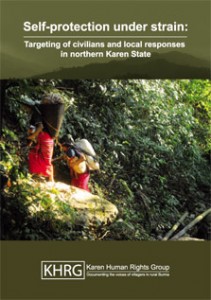Self-protection under strain: Targeting of civilians and local responses in northern Karen State
By Karen Human Rights Group • August 31, 2010 The SPDC Army continues to attack civilians and civilian livelihoods nearly two years after the end of the 2005-2008 SPDC Offensive in northern Karen State. In response, civilians have developed and employed various self-protection strategies that have enabled tens of thousands of villagers to survive with dignity and remain close to their homes despite the humanitarian consequences of SPDC Army practices. These protection strategies, however, have become strained, even insufficient, as humanitarian conditions worsen under sustained pressure from the SPDC Army, prompting some individual villagers and entire communities to re-assess local priorities and concerns, and respond with alternative strategies – including uses of weapons or landmines. While this complicates discussions of legal and humanitarian protections for at-risk civilians, uses of weapons by civilians occur amidst increasing constraints on alternative self-protection measures. External actors wishing to promote human rights in conflict areas of eastern Burma should therefore seek a detailed understanding of local priorities and dynamics of abuse, and use this understanding to inform activities that broaden civilians’ range of feasible options for self-protection, including beyond uses of arms.
The SPDC Army continues to attack civilians and civilian livelihoods nearly two years after the end of the 2005-2008 SPDC Offensive in northern Karen State. In response, civilians have developed and employed various self-protection strategies that have enabled tens of thousands of villagers to survive with dignity and remain close to their homes despite the humanitarian consequences of SPDC Army practices. These protection strategies, however, have become strained, even insufficient, as humanitarian conditions worsen under sustained pressure from the SPDC Army, prompting some individual villagers and entire communities to re-assess local priorities and concerns, and respond with alternative strategies – including uses of weapons or landmines. While this complicates discussions of legal and humanitarian protections for at-risk civilians, uses of weapons by civilians occur amidst increasing constraints on alternative self-protection measures. External actors wishing to promote human rights in conflict areas of eastern Burma should therefore seek a detailed understanding of local priorities and dynamics of abuse, and use this understanding to inform activities that broaden civilians’ range of feasible options for self-protection, including beyond uses of arms.
Read the introduction, executive summary and recommendations.
Download the full report in English , Karen and Burmese.
Tags: Humanitarian Assistance, Karen, Karen Human Rights Group, Military, ResistanceThis post is in: Crimes Against Humanity
Related PostsUNSC Burma Meeting : Action Needed on Shan and Kachin Conflict
Myanmar: Floods Emergency Situation Report ( No.3)
Statement on Floods in Myanmar
Humanitarian Aid not Political Maneuvering
Myanmar: Floods Emergency Situation Report ( No.2)









 All posts
All posts